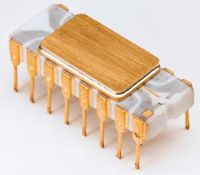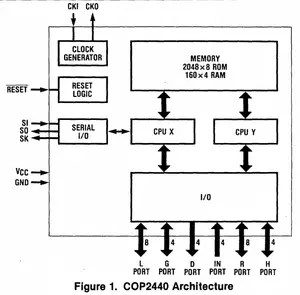(→First Neural Processor) |
(→First Microprocessor) |
||
| (5 intermediate revisions by 3 users not shown) | |||
| Line 15: | Line 15: | ||
Just two years earlier, in 1937, [[George Stibitz]] conceived his own relay-based digital computer, the ''[[Model K]]'' at [[Bell Labs]]. By the end of the year Bell Labs authorized a full research project which resulted in the ''[[Model I]]'' (formerly the ''Complex Number Computer'') in late 1939. | Just two years earlier, in 1937, [[George Stibitz]] conceived his own relay-based digital computer, the ''[[Model K]]'' at [[Bell Labs]]. By the end of the year Bell Labs authorized a full research project which resulted in the ''[[Model I]]'' (formerly the ''Complex Number Computer'') in late 1939. | ||
| − | Around the very same time the ABC was being developed in the United States, [[Konrad Zuse]], a German civil engineer, conceived the ''[[Z2]]''. The Z2 was a [[relay computer|relay-based digital computer]] consisting of around 2,000 relays. Allied bombing during World War II destroyed much of the original plans. | + | Around the very same time the ABC was being developed in the United States, [[Konrad Zuse]], a German civil engineer, conceived the ''[[Z2]]''. The Z2 was a [[relay computer|relay-based digital computer]] consisting of around 2,000 relays. Allied bombing during World War II destroyed much of the original plans. |
| + | |||
| + | == First Transistor == | ||
| + | The first practical transistor, a bipolar point-contact transistor, was invented by William Shockley, John Bardeen and Walter Brattain at Bell Labs in 1947. | ||
| + | |||
| + | === First MOS Transistor === | ||
| + | The first [[MOSFET]] (metal-oxide-semiconductor field-effect transistor), also known as the MOS transistor, was invented by Mohamad Atalla and Dawon Kahng at Bell Labs in 1959. | ||
| + | |||
| + | === First CMOS Transistor === | ||
| + | The first [[CMOS]] (complementary MOS) transistor was invented by Chih-Tang Sah and Frank Wanlass at Fairchild Semiconductor in 1963. | ||
== First Microprocessor == | == First Microprocessor == | ||
| Line 26: | Line 35: | ||
* [[Texas Instruments]]' {{ti|TMX1795}} | * [[Texas Instruments]]' {{ti|TMX1795}} | ||
| − | With development starting in 1968 and completing around June of 1970, the [[MP944]] chipset is one of the earliest examples of a complete VLSI micro-computer system chipset. The [[MP944]] is 20-bit microprocessor designed by Garrett AiResearch specifically for the [[wikipedia:Grumman F-14 Tomcat|Grumman F-14 Tomcat]]'s Central Air Data Computer. The project remained classified for over 40 years. In early 1970 at least three additional microprocessors were already under development. Intel started working on the {{intel|4004}} in April 1970. According to a number of | + | With development starting in 1968 and completing around June of 1970, the [[MP944]] chipset is one of the earliest examples of a complete VLSI micro-computer system chipset. The [[MP944]] is 20-bit microprocessor designed by Garrett AiResearch specifically for the [[wikipedia:Grumman F-14 Tomcat|Grumman F-14 Tomcat]]'s Central Air Data Computer. The project remained classified for over 40 years. In early 1970 at least three additional microprocessors were already under development. Intel started working on the {{intel|4004}} in April 1970. According to a number of sources, the Fairchild's PPS-25 was initially introduced in the second quarter 1971<ref>Ogdin, Jerry. "Microprocessor scorecard." Euromicro Newsletter 1.2 (1975): 43-77.</ref>. This would place it 2 quarters ahead of Intel's {{intel|4004}} which was introduced in November 1971. [[TI]] announced, albeit never actually commercialized, the {{ti|TMX1795}} which is effectively TI's own implementation of Intel's {{intel|8008}} - both were based on the same specifications drafted by the [[Computer Terminal Corporation]]. |
=== First Commercial Microprocessor === | === First Commercial Microprocessor === | ||
| − | From the list above, two processors might qualify for the "first commercial microprocessor" | + | From the list above, two processors might qualify for the "first commercial microprocessor". |
* [[Intel]]'s {{intel|MCS-4/4004|4004}} | * [[Intel]]'s {{intel|MCS-4/4004|4004}} | ||
Latest revision as of 00:25, 19 January 2022
First in computer engineering is almost always a controversial topic. Historically, many products were often designed around the same time by different organizations and were introduced around the same time. Below is a list of "firsts".
Contents
First Digital Computer[edit]
The argument over the first general purpose digital computer was so controversial, it actually made it all the way to a U.S. federal court. Candidates for the first digital computer:
Atanasoff's computer, Atanasoff–Berry computer (ABC) was conceived in 1939 at the Iowa State University where he worked along with the help of a graduate student, Clifford Berry. In 1947, ENIAC applied for US Patent 3120606 for their computer which was granted in 1964. In the landmark case Honeywell, Inc. v. Sperry Rand Corp., in a controversial ruling, the court credited John Vincent Atanasoff with the invention of the electronic digital computer. The same case ended up invalidating the ENIAC patent, leaving the invention of the electronic digital computer in the public domain.
Just two years earlier, in 1937, George Stibitz conceived his own relay-based digital computer, the Model K at Bell Labs. By the end of the year Bell Labs authorized a full research project which resulted in the Model I (formerly the Complex Number Computer) in late 1939.
Around the very same time the ABC was being developed in the United States, Konrad Zuse, a German civil engineer, conceived the Z2. The Z2 was a relay-based digital computer consisting of around 2,000 relays. Allied bombing during World War II destroyed much of the original plans.
First Transistor[edit]
The first practical transistor, a bipolar point-contact transistor, was invented by William Shockley, John Bardeen and Walter Brattain at Bell Labs in 1947.
First MOS Transistor[edit]
The first MOSFET (metal-oxide-semiconductor field-effect transistor), also known as the MOS transistor, was invented by Mohamad Atalla and Dawon Kahng at Bell Labs in 1959.
First CMOS Transistor[edit]
The first CMOS (complementary MOS) transistor was invented by Chih-Tang Sah and Frank Wanlass at Fairchild Semiconductor in 1963.
First Microprocessor[edit]

The first microprocessor is a subject of heated debate. Below is a number of popular candidates:
With development starting in 1968 and completing around June of 1970, the MP944 chipset is one of the earliest examples of a complete VLSI micro-computer system chipset. The MP944 is 20-bit microprocessor designed by Garrett AiResearch specifically for the Grumman F-14 Tomcat's Central Air Data Computer. The project remained classified for over 40 years. In early 1970 at least three additional microprocessors were already under development. Intel started working on the 4004 in April 1970. According to a number of sources, the Fairchild's PPS-25 was initially introduced in the second quarter 1971[1]. This would place it 2 quarters ahead of Intel's 4004 which was introduced in November 1971. TI announced, albeit never actually commercialized, the TMX1795 which is effectively TI's own implementation of Intel's 8008 - both were based on the same specifications drafted by the Computer Terminal Corporation.
First Commercial Microprocessor[edit]
From the list above, two processors might qualify for the "first commercial microprocessor".
First CMOS Microprocessor[edit]
The first CMOS microprocessor is the 8-bit RCA 1802 introduced in 1974.
First N-bit Microprocessor[edit]
Title Year Designer Processor Note First 4-bit Microprocessor 1971 Intel 4004 Fairchild PPS-25 First 8-bit Microprocessor 1971/2 Intel 8008 TI TMX1795 Never commercialized. First 16-bit Microprocessor 1973 National IMP-16 First 32-bit Microprocessor 1979 Bell Labs Bellmac-32 Never commercialized. 1981 Intel APX 432 First 64-bit Microprocessor 1991 MIPS Technologies R4000
First Dual-Core[edit]
The first known example of a commercial dual-core microprocessor is the COP II COP2404 (and 2440/41/42 variants) announced in 1981 and released the following year. The chip was a complete a single-chip dual-core processor.
First Neural Processor[edit]
The first commercial analog neural processor is the ETANN introduced by Intel. Below is a number of candidates for first commercial (digital/analog):
- Intel ETANN
- Fujitsu TDM Neurochip
- Micro Devices MD-1220
- American NeuraLogix NLX-420
References[edit]
- ↑ Ogdin, Jerry. "Microprocessor scorecard." Euromicro Newsletter 1.2 (1975): 43-77.

